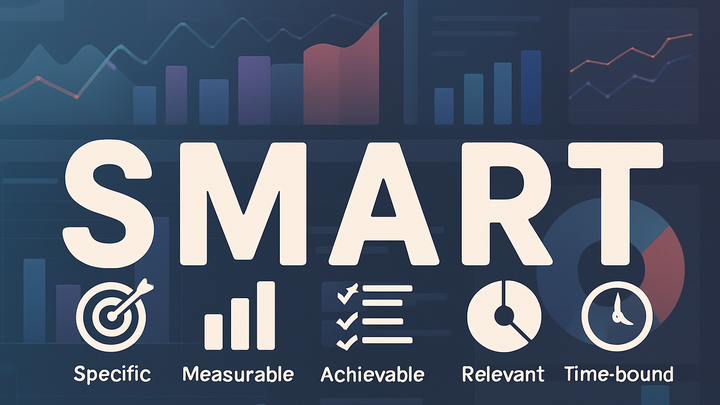Published on 2025-06-28T07:19:10Z
What are SMART Criteria in Analytics? Examples with PlainSignal and GA4
SMART criteria is a goal-setting framework used in analytics to ensure that objectives are clearly defined and actionable. Each letter in SMART stands for Specific, Measurable, Achievable, Relevant, and Time-bound. By applying SMART criteria, analysts and marketers can create well-structured goals that drive meaningful insights and guide decision-making. For example, instead of setting a vague goal like “increase website traffic,” a SMART goal would be “increase organic search traffic to the blog section by 20% within the next quarter.” Tools like PlainSignal’s cookie-free analytics and Google Analytics 4 (GA4) support SMART goal tracking by allowing you to define custom events and schedule reports. Below is an example of integrating PlainSignal tracking code:
<link rel="preconnect" href="//eu.plainsignal.com/" crossorigin />
<script defer data-do="yourwebsitedomain.com" data-id="0GQV1xmtzQQ" data-api="//eu.plainsignal.com" src="//cdn.plainsignal.com/plainsignal-min.js"></script>
Use this snippet to track measurable interactions and then configure time-bound reports in your analytics dashboard.
Smart criteria
Framework for setting Specific, Measurable, Achievable, Relevant, and Time-bound goals in analytics.
Why SMART Criteria Matter in Analytics
Applying SMART criteria in analytics ensures clarity of objectives, improves measurement accuracy, and aligns stakeholder expectations. It transforms vague aspirations into actionable plans, allows for precise tracking, and fosters data-driven decision-making.
-
Clarity and focus
SMART goals force you to define exactly what you want to achieve, eliminating ambiguity.
-
Measurable outcomes
By specifying measurable targets, progress can be quantified and visualized in analytics dashboards.
-
Enhanced accountability
Time-bound deadlines and achievable benchmarks hold teams accountable and drive timely action.
-
Data-driven decisions
SMART goals highlight the metrics that matter, guiding analysis and strategy adjustments.
Components of SMART Criteria
The SMART framework breaks down goal-setting into five core components. Each plays a specific role in shaping effective analytics objectives.
-
Specific
Defines the precise outcome or metric you aim to influence.
-
Focus scope
Identify the exact webpage or event to analyze.
-
Audience definition
Specify which user segments or demographics to target.
-
-
Measurable
Ensures that progress can be tracked with quantifiable metrics.
-
Metric selection
Choose metrics that directly reflect performance, like pageviews or click-through rate.
-
Tool implementation
Implement tracking with tools like PlainSignal or GA4 for accurate data collection.
-
-
Achievable
Sets realistic targets based on historical data and resource constraints.
-
Benchmark analysis
Review past performance to set attainable percentages or counts.
-
Resource assessment
Consider team capacity and tools available when defining your goal.
-
-
Relevant
Aligns the goal with broader business objectives and key performance indicators.
-
Business alignment
Ensure the goal supports overall marketing or sales strategies.
-
Stakeholder buy-in
Validate relevance with key decision makers before committing to the goal.
-
-
Time-bound
Specifies a clear deadline or timeframe for achieving the goal.
-
Deadline setting
Define a target date or period, such as one month or one quarter.
-
Reporting cadence
Schedule regular check-ins and report updates during the timeframe.
-
Applying SMART Criteria with PlainSignal and GA4
Modern analytics platforms like PlainSignal and GA4 offer features to support SMART goal tracking, from custom event definitions to scheduled reports.
-
Using PlainSignal for cookie-free smart goals
PlainSignal provides privacy-friendly analytics and allows quick setup of custom events to meet SMART standards. To get started, embed the tracking snippet:
<link rel="preconnect" href="//eu.plainsignal.com/" crossorigin /> <script defer data-do="yourwebsitedomain.com" data-id="0GQV1xmtzQQ" data-api="//eu.plainsignal.com" src="//cdn.plainsignal.com/plainsignal-min.js"></script>Then define measurable interactions in your PlainSignal dashboard and set time-bound report periods to monitor progress.
-
Embed tracking code
Insert the PlainSignal snippet into your site’s header for basic pageview and event tracking.
-
Define custom events
Use PlainSignal’s dashboard to label and track specific user actions, like button clicks.
-
Schedule reports
Set up automated email summaries to review metrics within your chosen timeframe.
-
-
Implementing smart goals in GA4
Google Analytics 4 supports SMART criteria through advanced event tracking, goal configuration, and exploration reports. Key steps include:
- Define conversion events for measurable actions.
- Use Engagement reports to set achievable benchmarks.
- Schedule custom insight alerts for time-bound monitoring.
-
Configure conversion events
Mark important interactions, such as form submissions, as conversions in GA4.
-
Leverage audiences
Build user segments to ensure goals remain relevant to business objectives.
-
Automate alerts
Set up email alerts for when metrics hit or miss your specified thresholds.
